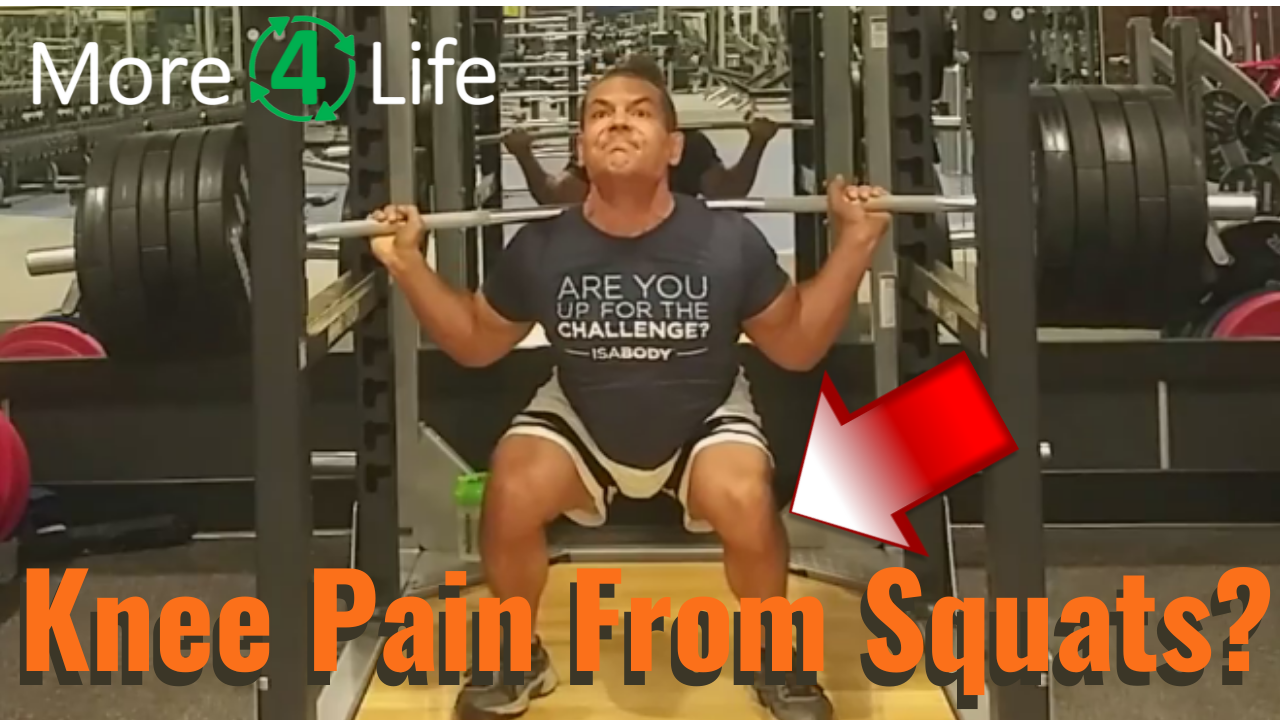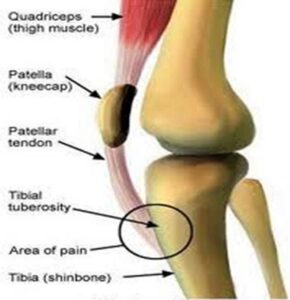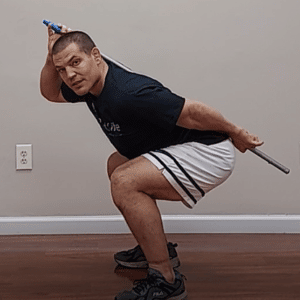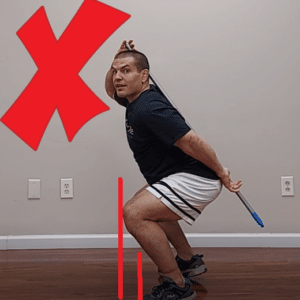Do You Get Knee Pain With Squats?
Watch the video to learn why your knee hurts from squats plus 4 easy tips to stop knee pain with squats.
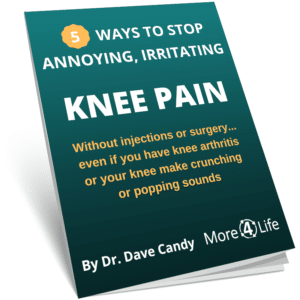
Why Your Knee Hurts From Squats
There are several things that can cause knee pain with squats.
Anatomically, knee pain with squats can come from a few different areas:
- Pain inside the knee joint - i.e. arthritis or meniscus tear
- Pain on the outside of the knee - i.e. IT Band pain
- Pain on inside of the knee - hamstring or hip adductor tendons
- Pain on the front of the knee - i.e. kneecap pain or patellar tendon pain
The last on this list, pain behind the kneecap or pain underneath the kneecap is the most common cause of knee pain with squats.
Patellofemoral (Kneecap) Pain With Squats
If your knee hurts behind the kneecap when you squat, chances are that you have some sort of patellofemoral pain.
This can happen from conditions like chondromalacia patella, which is a wearing down of the cartilage behind the kneecap. Chondromalacia is a precursor to arthritis, where you actually start to lose cartilage behind the kneecap.
Both of these have the same net result just to different extents:
They cause friction between the back of the knee and the thigh bone as you squat, which can create inflammation.
So what do you do if your knee hurts from squats due to chondromalacia or kneecap arthritis?
I'll answer that question below in just a moment.
First though, let's discuss the other type of pain on the front of the knee with squats:
Patellar Tendon Knee Pain With Squats
As shown in the image above, the patellar tendon attaches the kneecap to the tibia, or lower leg bone.
When you put too much tension through your quadriceps muscles when squatting, that creates tension on the patellar tendon. The tendon can either get overstretched, or irritate it's attachment site on the tibia.
Need Help For Knee Pain?
Request an appointment with one of our Specialist Physical Therapists to learn how we can help
How To Do Squats Without The Front Of Your Knee Hurting
As noted above, pain on the front of the knee with squats - whether from patellofemoral pain or patellar tendonitis - is usually causes by too much force from the quadriceps muscles.
While it's true that squats are a quadriceps strengthening exercise, it's also a compound movement - meaning it uses multiple muscle groups across multiple joints.
The quadriceps (front of thigh muscles) work to straighten your knee.
The gluteal muscles and hamstring muscles extend the hip joint
When you do squats, you're both straightening the knees while extending the hips, so if you can use MORE of the hip extension movement, there's less force on your kneecaps and patellar tendon.
How Do You Squat With Less Knee Extension Force?
By keeping your weight more on your heels and leaning your trunk forward, you create more hip flexion (bending) as you're lowering into a squat, and then you can use more hip extension to raise up from a squat.
This also helps you keep your lower back in a more neutral position.
Many strength coaches don't know squat
Many high school strength coaches are either football coaches or gym teachers. Most aren't highly educated in biomechanics or injury prevention.
So when you're learning to squat in high school sports or gym classes, many people are taught to keep their chest up and their trunk upright.
But that's not good for your lower back or for your knees!
If you keep your trunk perfectly upright while squatting, you're going to fall backwards.
That's just physics.
If your center of gravity falls behind your feet (base of support), you'll fall backwards.
In order to keep your center of gravity over your feet, you NEED to lean your trunk forwards.
And in order to do that, you have to bend from the hips.
As you can see in the video, keeping your spine STRAIGHT isn't the same thing as keeping it UPRIGHT.
Knees In Front Of Toes When Squatting?
Largely, not a good idea.
When your knees go in front of your toes, it creates more knee bend, and thus a higher patellofemoral compression force (kneecap on thigh force).
You can keep your trunk more upright while doing this, but it puts more pressure on your knees.
Knee Pain On The Inside Or Outside Of The Knee With Squats
Now what if your knee hurts on the inside or outside of the knee from squats?
This type of pain often comes from a problem in the side-to-side (frontal) plane when squatting.
If your knees go to far inward when you squat, it causes the tissues on the inside of the knees to get overstretched.
These include the:
- hamstring tendon (semitendinosus)
- gracilis tendon
- sartorius tendon
- medial collateral ligament (MCL)
Additionally, the knee rotates inward causing the IT band to get overstretched around the outside of the knee.
Either of these problems can make your knee hurt from squats.
How To Stop Pain Inside & Outside Of Knee With Squats
How You Position Your Feet Matters
Every person's anatomy is a little different, and not every person's feet naturally point straight ahead.
Some people have feet that toe-in, some people have feet that toe-out, and some people have feet that DO naturally point straight ahead.
That's a function of how your hip joints formed during development and there's nothing you can do to change that.
You just have to accommodate your movement patterns based on your anatomical make-up.
How do you know where to line up your feet for squats?
The easiest way to line up your feet is to close your eyes and move around a little bit. Then come to a relaxed standing position that feels normal to you.
Now open your eyes and look down to see where your feet are positioned.
That's likely pretty close to your natural alignment.
Align Your Knees With Your Toes
Once you know your natural foot alignment, rotate your knees inward or outward to align your knees with your toes.
- If your feet turn out, you will need to turn your knees out as well.
- If your feet turn in, you will need to turn your knees in as well.
Now when you squat, you'll need to maintain your knee-to-toe alignment as you squat, as well as when you stand back up in order to avoid knee pain from squats.
Need More Help For Knee Pain?
If you try the tips in this post and you're still having knee pain from squats, tap the button below to request an appointment with one of our specialists to get one-on-one help for your knee pain.
Like this post? Learn more exercises for knee pain
My Knee Hurts When Doing Lunges! 7 Tips To Stop Knee Pain From Lunges
7 Quad Stretches For Knee Pain
Hamstring Stretches To Relieve Tight, Stiff Muscles In Back Of Leg

